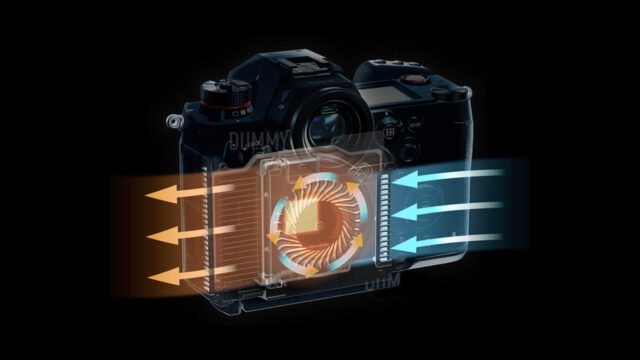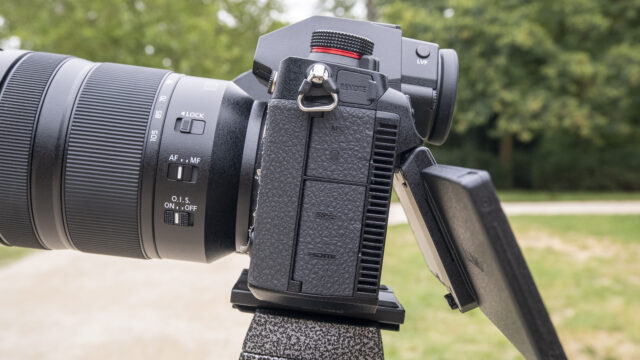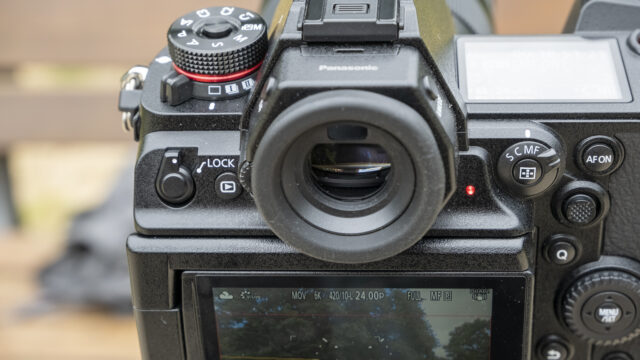Panasonic LUMIX S1H – Full Specs & Details, First Look at the 6K Full-Frame Mirrorless
The LUMIX S1H is Panasonic’s new flagship mirrorless full-frame camera that was revealed a couple of months ago at Cine Gear. Now, this “video-first” mirrorless has been officially announced. This 6K camera was designed with filmmakers in mind. Let’s take a closer at everything the S1H has to offer!
The Panasonic LUMIX S1H is pretty similar to the LUMIX S1 in terms of photo capabilities. This article is focused on all the video functionalities of the camera.
6K, Full-Frame 4K, Super35 Crop – All the Resolutions
In our previous article, we already knew that the Panasonic LUMIX S1H would be a camera that can record very high-quality/resolution footage. Now we know for sure that it can record in 6K at up to 24 frames per second (in a 3:2 aspect ratio for anamorphic shooting) or 5.9K at 30p in a 16:9 aspect ratio. Also, you can shoot 10-bit 4:2:2 4K/C4K footage at up to 29.97p internally with a bitrate of 400Mbps, and up to 60p by feeding an external recorder via the HDMI output. Below is a complete list of all the recording formats available.
The list of recording formats, frame rates, resolutions, and bitrates is impressive and extremely extensive. We can’t think of another mirrorless cameras which offers this amount of flexibility. A dedicated new custom list of recording formats can be created to speed up your workflow. It allows you to recall your most-used settings combinations quickly.
Most resolutions are available in full-frame mode, which means the camera uses the entire sensor to record the image, and there’s no crop. A Super 35mm mode is available too if you want to crop your footage to the traditional frame size, while maintaining 4K resolution.
What’s most impressive is for one that the camera can record the full 3:2 sensor in 6K resolution for anamorphic shooting. This mode, too, is recorded in a 10-bit color space, albeit with 4:2:0 color sampling, and at 200 MBit. When you change to the 16:9 full-frame mode, you can shoot 4K DCI (what Panasonic calls “C4K” in their table above) in 4:2:2 10-bit in 400 MBit, and that’s the other – even more impressive – feature of this camera.
If you want to shoot anamorphic, you can de-squeeze the image in-camera for viewing purposes. Depending on the lenses you use, several de-squeeze aspect ratios are available: 1.30x, 1.33x, 1.5x, 1.8x, and 2.0x.
6K Test Footage Shot on Pre-Production Version of LUMIX S1H for Download
My colleague Johnnie was able to have an hour with a pre-production version of the camera to take some shots. Just to “prove that it works”, he set the camera to 6K resolution (which comes with the 3:2 aspect ratio for anamorphic shooting) but he used normal spherical lenses. So if you want to download some original shots with an unusual aspect ratio in 6K, you can do it here (2.9 GB download).
In-Body Stabilization
The Panasonic LUMIX S1H incorporates a 5-axis Body I.S. (Image Stabilizer) to stabilize your footage if you are shooting hand-held. If you combine the camera with an O.I.S. lens (Optical Image Stabilizer, 2-axis), you have access to the Dual I.S. 2 technology. This stabilization combo and technology, which you can already found on the LUMIX GH5, can be expected to work beautifully. For some reason, this feature did not find its way into the GH5’s sibling, the GH5S.
No Recording Limit, Optional File Segmenting
In every S1H recording mode, there is no recording limit – so you can record non-stop as long as you have enough power/memory cards. Keep in mind that files could be segmented, but the recording won’t stop. Also, there is an optional “segmented file recording” option that can be pretty handy to avoid losing data if the camera runs out of battery in the middle of a take. With this option, the video can be recorded while it is divided into 1-minute segments. The video is saved as a single group.
The camera uses a newly developed 24.2-megapixel full-frame CMOS sensor, which measures 35.6mm x 23.8mm. There is an OLPF (optical low pass filter) that should suppress moiré.
Active Cooling System
If you ever shot for an extended time with a DSLR/Mirrorless camera, you probably know that they are prone to overheating issues. The cameras usually stop or shut off because the sensor is getting too hot. To solve that problem, the team at Panasonic put an active cooling system into the camera, near the sensor. This fan should help cooling down the sensor and allow you to shoot for an unlimited period even in hot conditions (or so it is claimed). We do not know yet if this negatively impacts the weather sealing of the camera.
Dual Native ISO
This sensor features Dual Native ISO technology, and a Venus Engine then processes the signal. In normal mode, the two native ISO are 100 and 640 (max. ISO: 204800). If you decide to shoot in V-Log/V-Gamut, the two native ISO jumps to 640 and 4000 (max. ISO: 51200). Finally, in HLG mode, the native ISO are 400 and 2500 (max. ISO: 204800).
V-Log, HDR/HLG, Monitoring Tools and New Articulating Screen
The Panasonic LUMIX S1H features various recording modes and picture profiles, including Cinelike Gamma, V-Log/V-Gamut, and HDR in HLG (Hybrid Log Gamma). You can finetune the color profiles by adjusting the knee control and the master pedestal level.
According to Panasonic, if you shoot in V-Log/V-Gamut, it is easy to match the camera with other VariCam products. You will get access to the “VariCam Look” and a claimed 14+ stops of dynamic range. We can’t wait to get our hands on the camera to test the dynamic range of the S1H in our lab. If you already have a VariCam LT/EVA1, it makes the LUMIX S1H a good B cam “on a budget.” As opposed to the GH5/GH5S, this is the “full” V-Log from the Varicam line, not V-Log L.
Also, you can record video in HDR (High Dynamic Range) mode. The camera records this Hybrid Log Gamma-video with a designated gamma curve compatible with ITU-R BT.2100.
With that many recording options and formats, the good thing is the S1H comes with a bunch of monitoring and viewing assist tools. For example, there is a Waveform Monitor – that you can scale and position where you want it on the screen – a vectorscope, zebra pattern, color bars, 1kHz test tone, video frame marker (to show the frame aspect), and V-Log View Assist. Tally lights are equipped on both the front and rear sides of the camera. A red frame indication can be displayed on the display/viewfinder when the camera is rolling.
Talking about monitoring, there is a 3.2-inch articulated LCD screen on the back of the camera, as well as an OLED viewfinder.
The LCD screen is 150% brighter than the ones on the LUMIX S1R/S1/GH5/GH5S. Even more importantly, the screen adopts a new mechanical structure and design, which means you can tilt/rotate it without the need to unplug an HDMI or USB cable. I like that because having to disconnect cables on the GH5 to tilt or rotate the built-in screen is a significant pain.
Also, the OLED display features a handy Live View Boost that boosts the sensitivity just for live view purposes. It should make your life easier when you are trying to frame your shot in low-light conditions perfectly.
High-Resolution OLED Viewfinder, Status LCD on Top
The “Real View Finder” as Panasonic calls it, is the same as the S1/S1R. It is an OLED display with a 5760k-dot resolution and a 10,000:1 contrast. It’s the highest resolution viewfinder there is in any camera right now, Sony uses a similar one for their latest Alpha series cameras. Latency shouldn’t be an issue with a time lag of only 0.005 sec. The 0.78x magnification ratio can be switched to 0.7x or 0.74x.
Finally, on top of the camera, there is the Status LCD, a 1.8-inch monochrome LCD with a backlight. It is “always-on” – as long as there is a battery inside the camera – and consumes minimum power. It shows you various information like your photo/video settings, how much time you can still record, the remaining battery life, and so on. Quite nicely, they have also put the audio meters on top of the cameras, which means that you could switch them off in the LCD or viewfinder for a “cleaner” feed of your video recording.
Autofocus
Regarding the autofocus, the S1H uses a technology that combines “lens, sensor and engine” according to Panasonic. In short, it means that the lens and sensor communicate at a maximum rate of 480 fps, and the engine does all the processing. You will have access to continuous AF with subject tracking, face, and eye detection.
The LUMIX S1H also incorporates Advanced AI Technology that detects specific subjects – humans and animals. The camera keeps tracking these subjects even when they turn their back to the camera.
We know that autofocus capabilities in Panasonic mirrorless cameras have improved significantly over the past few firmware updates. We tested and compared results in GH5 and GH5S updates that were released in October last year, and we saw a significant improvement in facial recognition. Panasonic informed us that there were additional enhancements since then that have found their way particularly into their S series full-frame cameras, which should have improved autofocus for video even further. We will test the autofocus capabilities of the S1H once we receive it for review.
LUMIX S1H Body, Card Slots, Connectivity, Lenses and Accessories
The Panasonic LUMIX S1H main structure is composed of a magnesium alloy full die-cast top/front/rear frame. Every joint/dial/button is weather-sealed, making the camera splash and dust resistant. If you are shooting in cold environments, the camera is freeze-resistant down to -10 degrees celsius. This is significantly better than most of the competition who often only guarantee the functionality of their cameras to 0 degrees celsius – which can quickly become a problem during an outdoor shooting in winter.
On the right side of the camera, there is a double SD memory card slot that is UHS-II and V90 compatible. Relay, backup, and allocation recording options are available. It’s kind of amazing that it seems to be possible to record every format simultaneously on both cards, even the highest-bitrate ones. There is also a “card lock” function which activates an alarm if the memory card door is opened when you are rolling. This option can be turned off.
On the right side, you will find a 3.5mm jack input, a headphone jack, a USB-C port that can be used to charge the internal battery, and the full-size HDMI port. On the front of the camera, there is a flash synchro terminal. This port doubles as a time code in/out port with the included BNC cable. The battery life is around 2 hours, and charging the battery takes the same time.

The Panasonic LUMIX S1H flash synchro terminal that doubles as a time code in/out port. Photo credit: cinema5D
There are two record buttons, one on top of the camera, and one on the front for easy access.
The S1H is an L-mount camera, so it is compatible with every L mount glass by Panasonic, Leica, or Sigma. In total, there should be more than 46 lenses and mount adapters by the end of 2020.
Alongside with the LUMIX S1H, Panasonic also announced two new lenses that will go with it – the LUMIX S PRO 24-70mm / f2.8 and the LEICA DG SUMMILUX 25mm / f1.4 II ASPH. We will report about those two lenses in a separate post.
The S1H comes with a lot of things in the box, including a useful HDMI cable lock holder. A couple of accessories will be natively compatible with the S1H, like an XLR adapter (DMW-XLR1), a battery grip (DMW-BGS1), a large eyecup (DMW-EC6), a DC coupler and so on. You can find an extensive list of all the accessories in the image below.
The S1H is Bluetooth 4.2a and Wi-Fi 5-GHz compatible so that you can control it via an app and a smartphone or tablet.
Pricing and Availability
At the time of writing, we were informed that the Panasonic LUMIX S1H will retail for around €4000 and $4000, respectively, and should be available at the end of September already.
Final Thoughts
Panasonic was extremely late to the party with their mirrorless full frame cameras, and when they first announced the S1, we weren’t so sure that they still had a chance to convince enough customers from the filmmaking crowd to jump ship from their Sony or other full-frame mirrorless cameras, and change to Panasonic. Now with the S1H in particular, and seeing all the incredible attention to detail and dedication for designated filmmaker functions that they put in this camera, we have to revise this worry. While we haven’t tested this camera yet, it is safe to say that this looks like the most fully-specced “pro video” mirrorless camera on the market so far. It’s missing very little of what a filmmaker can expect from such a camera (we’re still hoping for build-in NDs in these small interchangeable lens cameras, but one can only dream ….). From the small stuff like tally lights and adjustable flip screen, to the “bigger” stuff like high-resolution viewfinder, adjustable waveform monitor and LUTs, to the “big” stuff like 6K anamorphic shooting and 4:2:2 10-bit full frame 400MBit DCI 4K video, Panasonic is obviously VERY serious about taking this market by storm. And they might do just that, if enough people take a closer look.
We’ll certainly take a closer look as soon as we get our hands on the camera for a proper extensive review. Stay tuned to cinema5D in the coming weeks!
What do you think of the Panasonic LUMIX S1H? Will you consider buying it? Let us know in the comments!
Disclaimer: This article includes significant contributions by site editor Nino Leitner (including but not only the final thoughts), who attended a Panasonic press event about the LUMIX S1H in Hamburg, Germany. Panasonic invited us to attend the press presentation among many other press colleagues from Europe, and paid for the flight and travel costs for the one-day event.







































